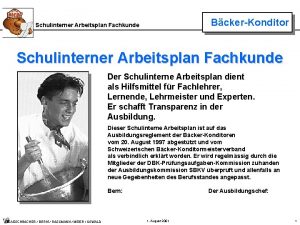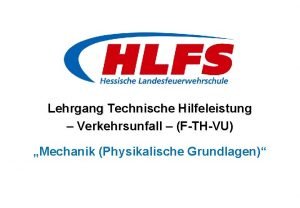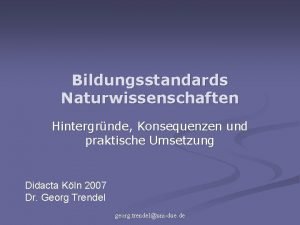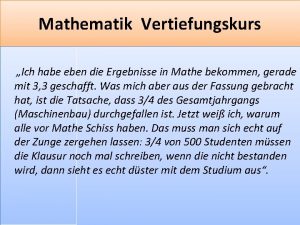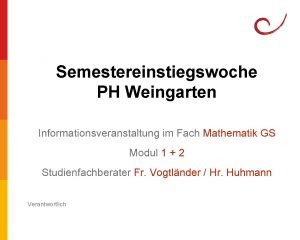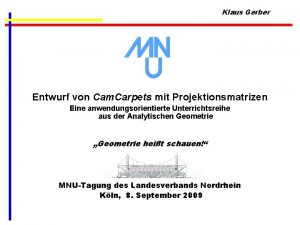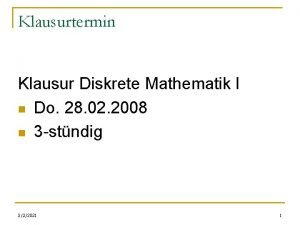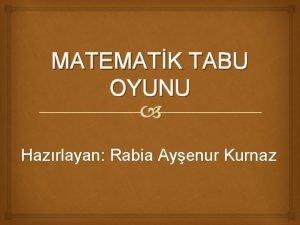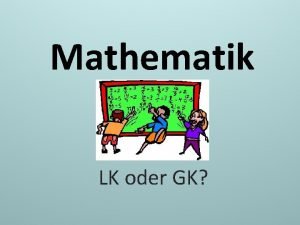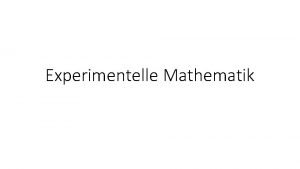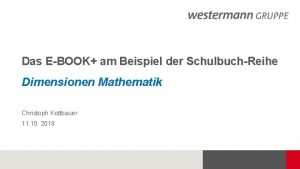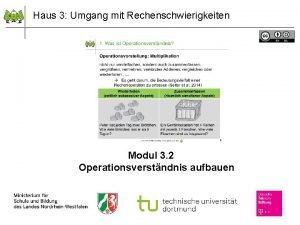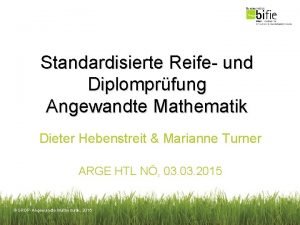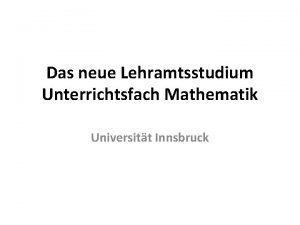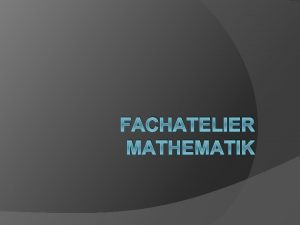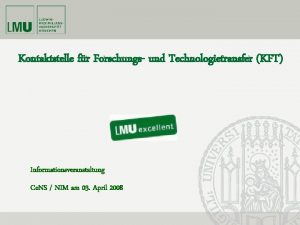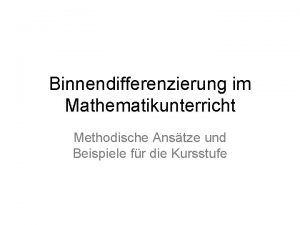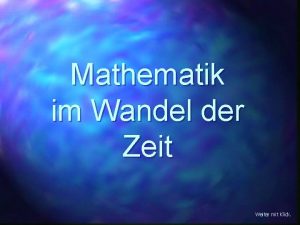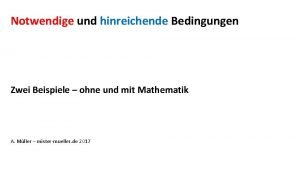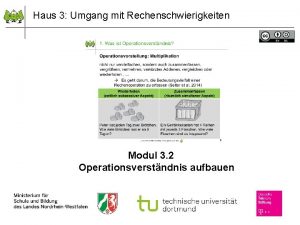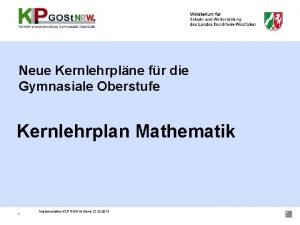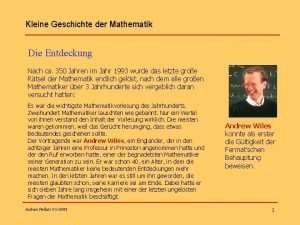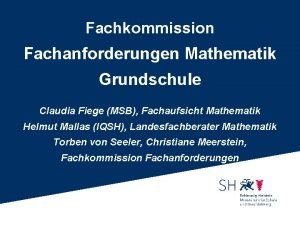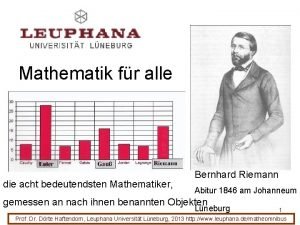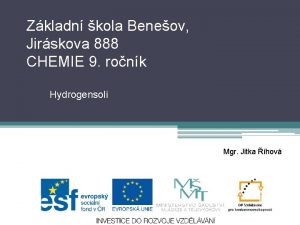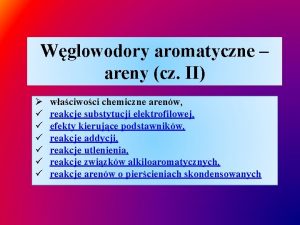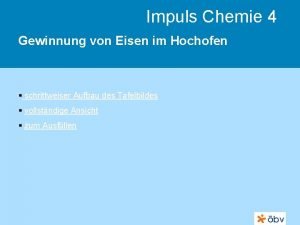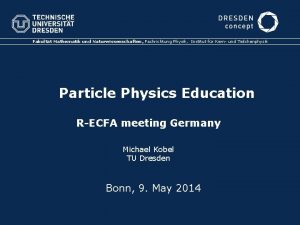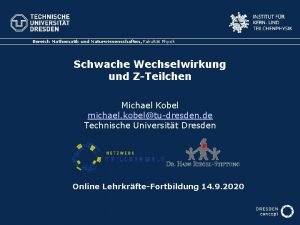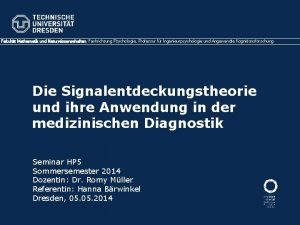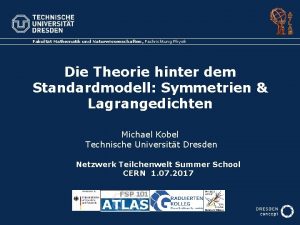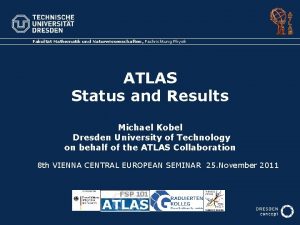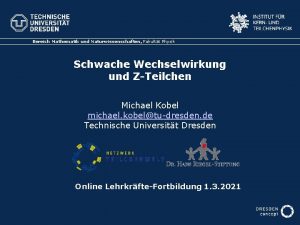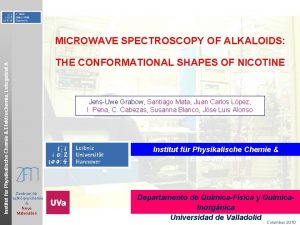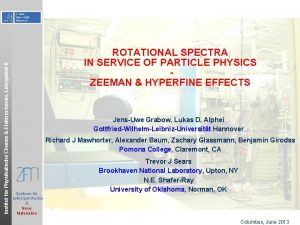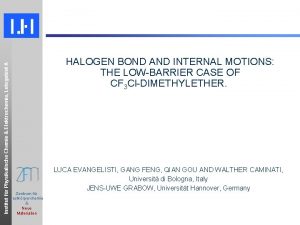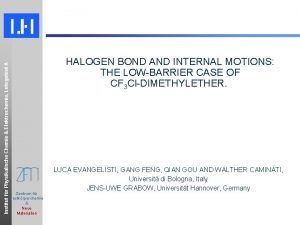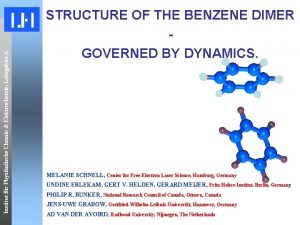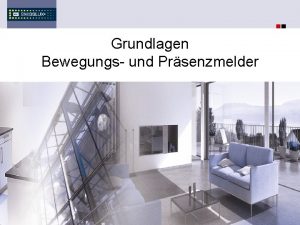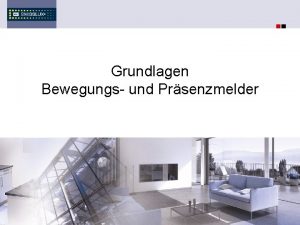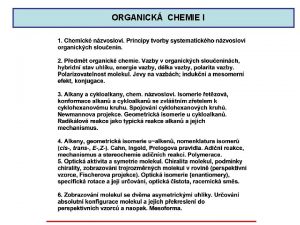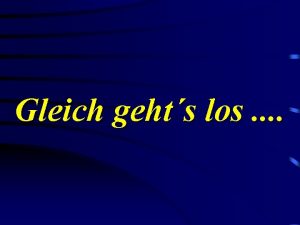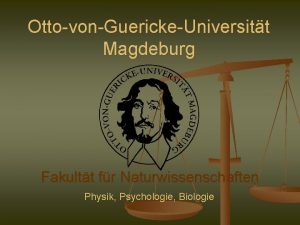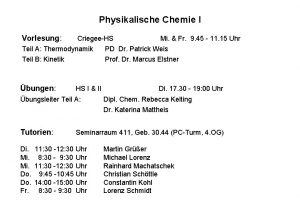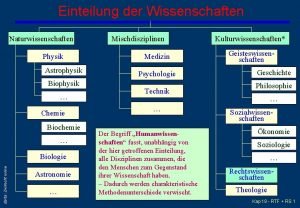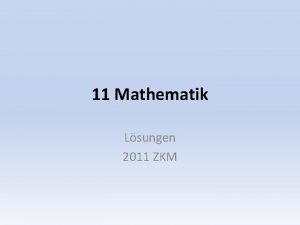Fakultt Mathematik und Naturwissenschaften Institut fr Physikalische Chemie





















![13 C NMR in Sc 3 N@C 80 d. TMS [ppm] Magn. Res. Chem. 13 C NMR in Sc 3 N@C 80 d. TMS [ppm] Magn. Res. Chem.](https://slidetodoc.com/presentation_image/24f7e27bf512a405503506e69a851d77/image-22.jpg)












- Slides: 34

Fakultät Mathematik und Naturwissenschaften, Institut für Physikalische Chemie und Elektrochemie Simulation of processes on nano scales using the DFTB method Thomas Heine Email: thomas. heine@chemie. tu-dresden. de

Off-topic: DFTx. TB: A quantum mechanical hybrid method Joint LCAO ansatz: D T D MO AO or c. GTO ND: Number if DFT basis functions NT: Number of TB basis functions AO Theor. Chem. Acc. 2005, 114, 68 Email: thomas. heine@chemie. tu-dresden. de

Off-topic: DFTx. TB: A quantum mechanical hybrid method Kohn-Sham matrix: L(l) and K(k) mean that l and k run over the basis functions that belong to the L and K atomic centres. Theor. Chem. Acc. 2005, 114, 68 Email: thomas. heine@chemie. tu-dresden. de

DFTB implementation in de. Mon Experimental version of de. Mon http: //www. demon-software. com Calculate matrix elements Solve secular equations parallelised using Open. MP (80% speedup), becomes sparse LAPACK+BLAS (MKL, ACML, ATLAS…) For ca. 5000 basis functions 85% of CPU time, Order-3 Calculate density and energy weighted density matrix BLAS (DSYRK) and Fortran 90 intrinsics Calculate gradients parallelised using Open. MP (100% speedup) Email: thomas. heine@chemie. tu-dresden. de

Calculation of matrix elements • All Overlap (S) and Kohn-Sham (F) integrals can be computed independently simple massive parallelisation possible • If Slater-Koster tables are employed, we –can interpolate matrix elements quickly –know the interaction range of each pair of atoms and can screen efficiently • For interatomic distances of ~5 Å matrix elements start to vanish –sparse matrix algebra (sub Order-3) –linear scaling for memory usage For the calculation of matrix elements there are no real limits for the applicability of the DFTB method. Email: thomas. heine@chemie. tu-dresden. de

Representation of Slater-Koster tables Fitting to Chebycheff-polynomials by Porezag et al. (Phys. Rev. B 1995, 51, 12947) – idea abandoned due to numerical instabilities. In de. Mon: local fitting, analytical derivatives are in principle available Email: thomas. heine@chemie. tu-dresden. de

DFTB implementation in de. Mon Experimental version of de. Mon http: //www. demon-software. com Calculate matrix elements Solve secular equations parallelised using Open. MP (80% speedup), becomes sparse LAPACK+BLAS (MKL, ACML, ATLAS…) For ca. 5000 basis functions 85% of CPU time, Order-3 Calculate density and energy weighted density matrix BLAS (DSYRK) and Fortran 90 intrinsics Calculate gradients parallelised using Open. MP (100% speedup) Email: thomas. heine@chemie. tu-dresden. de

Solving the secular equations • This is the most time-consuming part of DFTB • Standard technique: Orthogonalisation of F (e. g. Cholesky decomposition) followed by diagonalisation • Popular algorithms: LAPACK 3 – Divide&Conquer (DQ) or Relatively Robust Representations (RRR) – claimed to be sub-Order-3 (sub Order-2 for RRR) – became much more stable in the past – no significant memory overhead required for RRR – give roughly a factor of 10 in performance compared to traditional diagonalisation methods – parallelisation possible (Sca. LAPACK), but • message passing is significant overall bad scalability • parallel versions are less stable than serial ones Email: thomas. heine@chemie. tu-dresden. de

DFTB implementation in de. Mon Experimental version of de. Mon http: //www. demon-software. com Calculate matrix elements Solve secular equations parallelised using Open. MP (80% speedup), becomes sparse LAPACK+BLAS (MKL, ACML, ATLAS…) For ca. 5000 basis functions 85% of CPU time, Order-3 Calculate density and energy weighted density matrix BLAS (DSYRK) and Fortran 90 intrinsics Calculate gradients parallelised using Open. MP (100% speedup) Email: thomas. heine@chemie. tu-dresden. de

Calculation of density matrix P, energy weighted density matrix W and gradients • Calculation of P and W involve essentially squaring a matrix: simple massive parallelisation possible • For the calculation of gradients, all arguments given before for the calculation of matrix elements apply: – fast calculation of derivatives – screening Email: thomas. heine@chemie. tu-dresden. de

For large-scale simulations: Avoid diagonalisation! • Our approach: Car-Parrinello DFTB • Theory and standard implementation: M. Rapacioli, R. Barthel, T. Heine, G. Seifert, to be submitted to JCP • Parallelisation, sparsity, large scale behaviour, tricks of the trade: M. Rapacioli, T. Heine, G. Seifert, in preparation (JPCA special section DFTB) Email: thomas. heine@chemie. tu-dresden. de

Car-Parrinello DFTB • Propagation of MO coefficients • S-1 is solved iteratively (conjugate gradient) • Only matrix-matrix operations are ^formally Order-3. These are computationally unproblematic (vectorisation and parallelisation) and become sparse “quickly” Email: thomas. heine@chemie. tu-dresden. de

Illustrative applications of the DFTB method as implemented in de. Mon 1. 2. 3. 4. Optimisation of many (~500, 000) isomers Long-time MD trajectories (ns region) Doing nasty things with nano-scale systems Explore complicated potential energy surfaces Email: thomas. heine@chemie. tu-dresden. de

Local minima of many isomers • C 36 has two isoenergetic isomers (36: 14 and 36: 15) • C 36 Hx, x=4, 6, have been found in mass spectrometer. But which isomer(s)? • Number of isomers to be calculated: 36: 14 36: 15 x Total Distinct Nonradical 2 630 90 90 630 41 41 4 58 905 7 461 7 317 58 905 2 608 2 553 82 123 74 549 6 1 947 793 243 985 221 665 1 947 793 J. Chem. Soc. , Perkin Trans. 2, 2001, 487– 490 Email: thomas. heine@chemie. tu-dresden. de

Which basis cage? dark: 36: 14 based light: 36: 15 based J. Chem. Soc. , Perkin Trans. 2, 2001, 487– 490 Email: thomas. heine@chemie. tu-dresden. de

Which are the stable isomers? (1, 4) positions at equatorial hexagons! side view top view point group relative energy [k. J/mol] J. Chem. Soc. , Perkin Trans. 2, 1999, 707– 711 Email: thomas. heine@chemie. tu-dresden. de

Sc 3 N@C 68: The first fullerene with adjacent pentagons • mass spectrum: Sc 3 N@C 68 • graph theory: C 68 must have adjacent pentagons • earlier calculations: adjacent pentagons energetically unfavoured • assumption: stabilisation by endohedral Sc 3 N molecule Nature 408 (2000) 427 -428 Email: thomas. heine@chemie. tu-dresden. de

13 C and 45 Sc NMR gives information on symmetry Nature 408 (2000) 427 -428 Graph theory: 11 isomers (point groups D 3 and S 6) out of 6332 are compatible with one 45 Sc and 11+1 13 C signals Email: thomas. heine@chemie. tu-dresden. de

Which Sc 3 N@C 68 isomer has been found? • minimum number of pentagon adjacencies: 6140 and 6275. • 6140 is 120 k. J/mol more stable than all other isomers. • Added excess electrons (2, 4, 6) to simulate charge transfer increase the energy gap Nature 408 (2000) 427 -428 Email: thomas. heine@chemie. tu-dresden. de

Simple explanation using Hückel and MO theory aromatic (4 N+2 rule) 6 e- not aromatic (hole in p system) antiaromatic (8 membered ring) • Sc 3 N@C 68: 3 adjacent pentagons connected to Sc • ~2 electrons per adjacent pentagon • isoelectronic with 10 membered ring (aromatic) Email: thomas. heine@chemie. tu-dresden. de

Confirmation by 13 C NMR fingerprint Nature 408 (2000) 427 -428 J. Phys. Chem. A 2005, 109, 70687072 Email: thomas. heine@chemie. tu-dresden. de
![13 C NMR in Sc 3 NC 80 d TMS ppm Magn Res Chem 13 C NMR in Sc 3 N@C 80 d. TMS [ppm] Magn. Res. Chem.](https://slidetodoc.com/presentation_image/24f7e27bf512a405503506e69a851d77/image-22.jpg)
13 C NMR in Sc 3 N@C 80 d. TMS [ppm] Magn. Res. Chem. 2004, 42, 199 Email: thomas. heine@chemie. tu-dresden. de

IR spectrum of Sc 3 N@C 80 unpublished Email: thomas. heine@chemie. tu-dresden. de

Electromechanical properties of single-walled carbon nanotubes Rupture of CNT’s at different temperatures: DFTB-based Born. Oppenheimer MD with successive iterations of pulling the tubes until rupture Small 2005, 1, 399 Email: thomas. heine@chemie. tu-dresden. de

Elastic properties of SWCNT’s 300 K: full circles 600 K: squares 1000 K: empty circles • Independent on temperature • Rupture at DL/L≈0. 15 • Hooke-like behaviour up to DL/L≈0. 1 Small 2005, 1, 399 Email: thomas. heine@chemie. tu-dresden. de

Mechanical properties of inorganic nanotubes Golden Gate bridge, San Francisco, steel cables Golden Gate bridge, San Francisco, after reconstruction with nanotubes Thanks to Sibylle Gemming Email: thomas. heine@chemie. tu-dresden. de

Electromechanical properties of CNTs Electronic transmission probability T(E) depends strongly on DL/L! Small 2005, 1, 399 Email: thomas. heine@chemie. tu-dresden. de

Axial tension of WS 2 and Mo. S 2 nanotubes • In standard materials: mechanical properties are affected, if not even determined, by defects • Nanotubes: almost defect free mechanical properties of almost ideal structure can be studied, and superior mechanical properties can be achieved • Special structure of WS 2/Mo. S 2 particularly interesting regarding the axial tension Email: thomas. heine@chemie. tu-dresden. de

Mechanical properties of Mo. S 2 nanotubes experiment Breaking a WS 2 nanotube with an AFM, in-situ SEM Proc. Natl. Acad. Sci. USA 2006, 103, 523. Email: thomas. heine@chemie. tu-dresden. de

Mechanical properties of Mo. S 2 nanotubes simulation Breaking a Mo. S 2 nanotube with an AFM Almost harmonic behaviour until rupture! Proc. Natl. Acad. Sci. USA 2006, 103, 523. Email: thomas. heine@chemie. tu-dresden. de

Speeding up the exploration of reaction mechanisms • Standard technique: • If no TS structure can be guessed, or if generality is required: • 1. Get an idea of the transition state(s) (TS) 2. optimise each TS 3. Compute internal reaction coordinates – Scan potential energy surface – Nudged Elastic Band (NEB) method – Both are computationally very expensive Our approach: 1. 2. 3. 4. Get an idea of the PES with NEB/DFTB Optimise TS with GGA-DFT Compute IRC with GGA-DFT Compute entropy corrections using GGA-DFT and harmonic approximation 5. Refine computations with higher level theory (MP 2, CCSD(T), MR methods Email: thomas. heine@chemie. tu-dresden. de

Ring formation in interstellar space NEB calculations (DFTB and DFT, de. Mon) IRC calculations, theory refinement, entropy corrections are still to be done Robert Barthel, TU Dresden, to be published Email: thomas. heine@chemie. tu-dresden. de

Conclusions • DFTB is a very fast QM method, and problems to go to large-scale systems can be overcome relatively easily • DFTB is a very robust method and hence allows to – study many (~10 n, n>5) systems in an automatised way – study rough processes, involving bond breaking and bond formation – study very long MD trajectories using the NVE ensemble with a numerical accuracy (energy conservation) comparable to MM methods – study finite (cluster, molecules) and infinite (solids, liquids, surfaces…) systems employing one method with identical approximations – predict stable subsystems without solving the complete problem • The accuracy of DFTB can be improved by SCC, but for the sake of losing the robustness of the method Email: thomas. heine@chemie. tu-dresden. de

Acknowledgements • Theoretical Chemistry group at TU Dresden – Mathias Rapacioli – Knut Vietze – Robert Barthel – Viktoria Ivanovskaya – Helio A. Duarte – Gotthard Seifert • ZIH Dresden for computational facilities • Alexander v. Humboldt foundation • Gesellschaft Deutscher Chemiker • Deutsche Forschungsgemeinschaft • J. Mc. Kelvey, M. Elstner, T. Frauenheim for invitation Email: thomas. heine@chemie. tu-dresden. de
 Physikalische lockerungsmittel
Physikalische lockerungsmittel Virtuelle adresse in physikalische umrechnen
Virtuelle adresse in physikalische umrechnen Schubkarre einseitiger hebel
Schubkarre einseitiger hebel Bildungsstandards naturwissenschaften
Bildungsstandards naturwissenschaften Naturwissenschaften in der informationsgesellschaft
Naturwissenschaften in der informationsgesellschaft Arbeitsblatt naturwissenschaften
Arbeitsblatt naturwissenschaften Zertifikatsklausur uni stuttgart 2020
Zertifikatsklausur uni stuttgart 2020 Bateman funktion
Bateman funktion Moopead
Moopead Camcarpets
Camcarpets Diskrete mathematik
Diskrete mathematik Lernausgangslage mathematik
Lernausgangslage mathematik Diskrete mathematik klausur
Diskrete mathematik klausur Matematik tabusu kartları
Matematik tabusu kartları Gliederung mathematik
Gliederung mathematik Experimentelle mathematik
Experimentelle mathematik Dimensionen mathematik 7 lösungen
Dimensionen mathematik 7 lösungen Malquartett
Malquartett Srdp mathematik aufgabenpool
Srdp mathematik aufgabenpool Technische mathematik innsbruck
Technische mathematik innsbruck Stellwerk mathematik
Stellwerk mathematik Kontaktstelle mathematik lmu
Kontaktstelle mathematik lmu Binnendifferenzierung mathematik
Binnendifferenzierung mathematik Mathematik im wandel der zeit
Mathematik im wandel der zeit Hinreichend notwendig mathe
Hinreichend notwendig mathe Malquartett pikas
Malquartett pikas Kernlehrplan mathematik
Kernlehrplan mathematik Wer endekte in mathematik
Wer endekte in mathematik Fachanforderungen mathematik
Fachanforderungen mathematik Dialogisches lernen mathematik
Dialogisches lernen mathematik Mathematik
Mathematik Chemie
Chemie Krasové jevy chemie
Krasové jevy chemie Areny chemie
Areny chemie Impuls chemie
Impuls chemie
